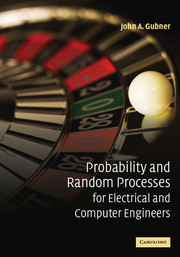Book contents
- Frontmatter
- Contents
- Chapter dependencies
- Preface
- 1 Introduction to probability
- 2 Introduction to discrete random variables
- 3 More about discrete random variables
- 4 Continuous random variables
- 5 Cumulative distribution functions and their applications
- 6 Statistics
- 7 Bivariate random variables
- 8 Introduction to random vectors
- 9 Gaussian random vectors
- 10 Introduction to random processes
- 11 Advanced concepts in random processes
- 12 Introduction to Markov chains
- 13 Mean convergence and applications
- 14 Other modes of convergence
- 15 Self similarity and long-range dependence
- Bibliography
- Index
1 - Introduction to probability
Published online by Cambridge University Press: 05 June 2012
- Frontmatter
- Contents
- Chapter dependencies
- Preface
- 1 Introduction to probability
- 2 Introduction to discrete random variables
- 3 More about discrete random variables
- 4 Continuous random variables
- 5 Cumulative distribution functions and their applications
- 6 Statistics
- 7 Bivariate random variables
- 8 Introduction to random vectors
- 9 Gaussian random vectors
- 10 Introduction to random processes
- 11 Advanced concepts in random processes
- 12 Introduction to Markov chains
- 13 Mean convergence and applications
- 14 Other modes of convergence
- 15 Self similarity and long-range dependence
- Bibliography
- Index
Summary
Why do electrical and computer engineers need to study probability?
Probability theory provides powerful tools to explain, model, analyze, and design technology developed by electrical and computer engineers. Here are a few applications.
Signal processing. My own interest in the subject arose when I was an undergraduate taking the required course in probability for electrical engineers. We considered the situation shown in Figure 1.1. To determine the presence of an aircraft, a known radar pulse v(t) is sent out. If there are no objects in range of the radar, the radar's amplifiers produce only a noise waveform, denoted by Xt. If there is an object in range, the reflected radar pulse plus noise is produced. The overall goal is to decide whether the received waveform is noise only or signal plus noise. To get an idea of how difficult this can be, consider the signal plus noise waveform shown at the top in Figure 1.2. Our class addressed the subproblem of designing an optimal linear system to process the received waveform so as to make the presence of the signal more obvious. We learned that the optimal transfer function is given by the matched filter. If the signal at the top in Figure 1.2 is processed by the appropriate matched filter, we get the output shown at the bottom in Figure 1.2. You will study the matched filter in Chapter 10.
Information
- Type
- Chapter
- Information
- Publisher: Cambridge University PressPrint publication year: 2006
